大家好,欢迎来到IT知识分享网。
正如我们先前所指出的,网络数据的基本单位永远是 byte(字节)。Java NIO 提供 ByteBuffer 作为字节的容器,但这个类是过于复杂,有点难以使用。
Netty 中 ByteBuffer 的替代是 ByteBuf,一个强大的实现,解决 JDK 的 API 的限制,以及为网络应用程序开发者一个更好的工具。 但 ByteBuf 并不仅仅暴露操作一个字节序列的方法; 这也是专门的 Netty 的 ChannelPipeline 的语义设计。
在本章中,我们会说明相比于 JDK 的 API,ByteBuf 所提供的卓越的功能和灵活性。这也将使我们能够更好地理解了 Netty 的数据处理。
1. Buffer API
主要包括
ByteBufByteBufHolder
Netty 使用 reference-counting (引用计数) 来判断何时可以释放 ByteBuf 或 ByteBufHolder 和其他相关资源,从而可以利用池和其他技巧来提高性能和降低内存的消耗。这一点上不需要开发人员做任何事情,但是在开发 Netty 应用程序时,尤其是使用 ByteBuf 和 ByteBufHolder 时,你应该尽可能早地释放池资源。
💡 引用计数:学习过 JVM 的小伙伴应该知道垃圾回收有引用计数法和可达性分析这两种算法判断对象是否存活,Netty 就使用了 引用计数法来优化内存的使用。引用计数确保了当对象的引用计数大于 1 时,对象就不会被释放,当计数减少至 0 时, 对象就会被释放,如果程序访问一个已被释放的引用计数对象,那么将会导致一个
IllegalReferenceCountException异常。 在 Netty 中,ByteBuf和ByteBufHolder都实现了ReferenceCounted接口。
Netty 的 Buffer API 提供了几个优势:
- 可以自定义缓冲类型
- 通过一个内置的复合缓冲类型实现零拷贝
- 扩展性好,比如
StringBuilder - 不需要调用
flip()来切换读/写模式 - 读取和写入索引分开
- 方法链
- 引用计数
- Pooling (池)
2. ByteBuf — Netty 字节数据的容器
ByteBuf 是一个很好的经过优化的数据容器,我们可以将字节数据有效的添加到 ByteBuf 中或从 ByteBuf 中获取数据。ByteBuf 有 2 部分:一个用于读,一个用于写。我们可以按顺序的读取数据,也可以通过调整读取数据的索引或者直接将读取位置索引作为参数传递给 get 方法来重复读取数据。
① ByteBuf 如何在工作
ByteBuf 维护了两个不同的索引:一个是用于读取的 readerIndex , 一个是用于写入的 writerIndex。
写入数据到 ByteBuf 后,writerIndex(写入索引)增加。开始读字节后,readerIndex(读取索引)增加。你可以读取字节,直到写入索引和读取索引处在相同的位置,ByteBuf 变为不可读。当访问数据超过数组的最后位,则会抛出 IndexOutOfBoundsException。
调用 ByteBuf 的 “read” 或 “write” 开头的任何方法都会提升相应的索引。另一方面,”set” 、 “get“操作字节将不会移动索引位置,他们只会操作相关的通过参数传入方法的相对索引。
可以给 ByteBuf 指定一个最大容量值,这个值限制着 ByteBuf 的容量。任何尝试将写入索引超过这个值的行为都将导致抛出异常。ByteBuf 的默认最大容量限制是 Integer.MAX_VALUE。
ByteBuf 类似于一个字节数组,最大的区别是读和写的索引可以用来控制对缓冲区数据的访问。下图显示了一个容量为16的空的 ByteBuf 的布局和状态,writerIndex 和 readerIndex 都在索引位置 0 :

② ByteBuf 使用模式
ByteBuf 有多种使用模式,我们可以根据需求构建不同使用模式的 ByteBuf。
Ⅰ HEAP BUFFER (堆缓冲区)
最常用的模式是 ByteBuf 将数据存储在 JVM 的堆空间,实际上是通过数组存储数据, 所以这种模式被称为支撑数组(Backing Array )。堆缓冲区可以在没有使用池化的情况下快速分配和释放,非常适合用来处理遗留数据的。它还提供了直接访问数组的方法,通过 ByteBuf.array() 来获取 byte[] 数据。
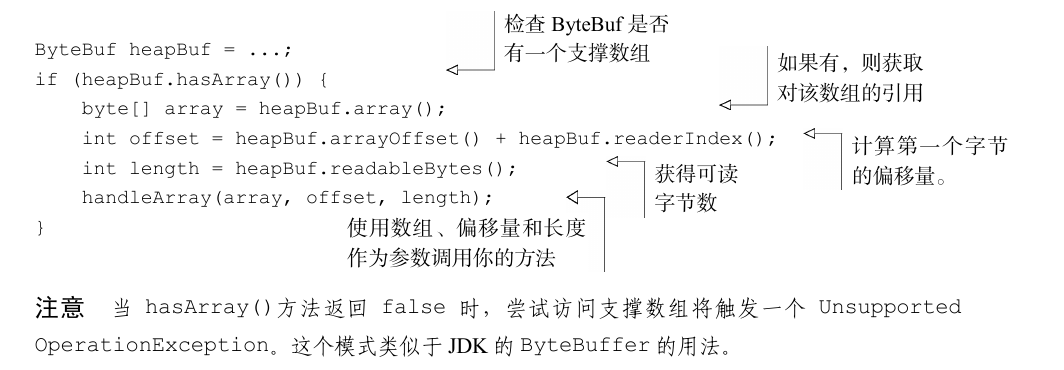
Ⅱ DIRECT BUFFER (直接缓冲区)
在 Java 中,我们创建的对象大部分都是存储在堆区之中的,但这不是绝对的。
在 NIO 的 API 中, 允许 Buffer 分配直接内存,即操作系统的内存。
这样做的好处非常明显: 前面在传输章节介绍过的零拷贝技术的 特点之一就是规避了多次 IO 拷贝。现在数据直接就在直接内存中,而不是在JVM应用进程中,这不仅减少了拷贝次数, 还减少了用户态与内核态的上下文切换。
直接缓冲区的缺点也比较明显: 直接内存的分配和释放都较为昂贵,而且因为直接缓冲区的数据不是在堆区的,所以我们在某些时候可能需要将直接缓冲区的数据先拷贝一个副本到堆区, 再对这个副本进行操作。 与支撑数组相比,直接缓冲区的工作可能更多,所以如果事先知道数据会作为一个数组来被访问,那么我们应该使用堆内存。

Ⅲ COMPOSITE BUFFER (复合缓冲区)
最后一种模式是复合缓冲区,我们可以创建多个不同的 ByteBuf,然后提供一个这些 ByteBuf 组合的视图 CompositeByteBuf。我们可以动态的向 CompositeByteBuf 中添加和删除其中的 ByteBuf 实例,JDK 的 ByteBuffer 没有这样的功能。
⚠ 警告:CompositeByteBuf.hasArray() 总是返回 false,因为它可能既包含堆缓冲区,也包含直接缓冲区
例如,一条消息由 header 和 body 两部分组成,将 header 和 body 组装成一条消息发送出去,可能 body 相同,只是 header 不同,使用 CompositeByteBuf 就不用每次都重新分配一个新的缓冲区。下图显示CompositeByteBuf 组成 header 和 body:
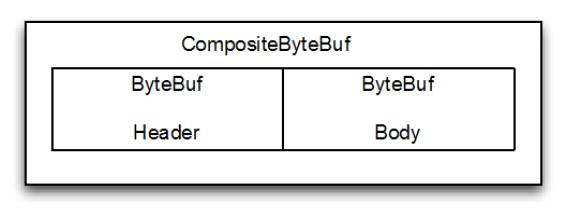
下面代码显示了使用 JDK 的 ByteBuffer 的一个实现。两个 ByteBuffer 的数组创建保存消息的组件,第三个创建用于保存所有数据的副本。
// 使用数组保存消息的各个部分
ByteBuffer[] message = { header, body };
// 使用副本来合并这两个部分
ByteBuffer message2 = ByteBuffer.allocate(
header.remaining() + body.remaining());
message2.put(header);
message2.put(body);
message2.flip();
这种做法显然是低效的,分配和复制操作不是最优的方法,操纵数组使代码显得很笨拙。
下面看使用 CompositeByteBuf 的改进版本:
ByteBuf headerBuf = ...; // 可以是堆缓冲区或直接缓冲区
ByteBuf bodyBuf = ...; // 可以是堆缓冲区或直接缓冲区
// 追加 ByteBuf 实例的 CompositeByteBuf
CompositeByteBuf messageBuf = ...;
messageBuf.addComponents(headerBuf, bodyBuf);
// ....
messageBuf.removeComponent(0); // 移除头
// 遍历所有 ByteBuf 实例
for (int i = 0; i < messageBuf.numComponents(); i++) { //3
System.out.println(messageBuf.component(i).toString());
}
3. 字节级别的操作
除了基本的读写操作, ByteBuf 还提供了它所包含的数据的修改方法。
① 随机访问索引
ByteBuf 使用从 0 开始的索引,第一个字节的索引是 0,最后一个字节的索引是 ByteBuf 的 capacity – 1,下面代码是遍历 ByteBuf 的所有字节:
ByteBuf buffer = ...;
for (int i = 0; i < buffer.capacity(); i++) {
byte b = buffer.getByte(i);
System.out.println((char) b);
}
⚠ 注意:通过索引访问时不会自动推进 readerIndex (读索引)和 writerIndex(写索引),当然我们可以通过 ByteBuf 的 readerIndex(index) 或 writerIndex(index) 来分别推进读索引或写索引
JDK 的 ByteBuffer 只有一个索引 position,所以当 ByteBuffer 在读和写模式之间切换时,需要使用 flip 方法。 而 ByteBuf 同时具有读索引和写索引,则无需切换模式,在 ByteBuf 内部,其索引满足:
0 <= readerIndex <= writerIndex <= capacity
当使用readerIndex读取字节,或使用writerIndex写入字节时,ByteBuf 内部的分段大致如下:
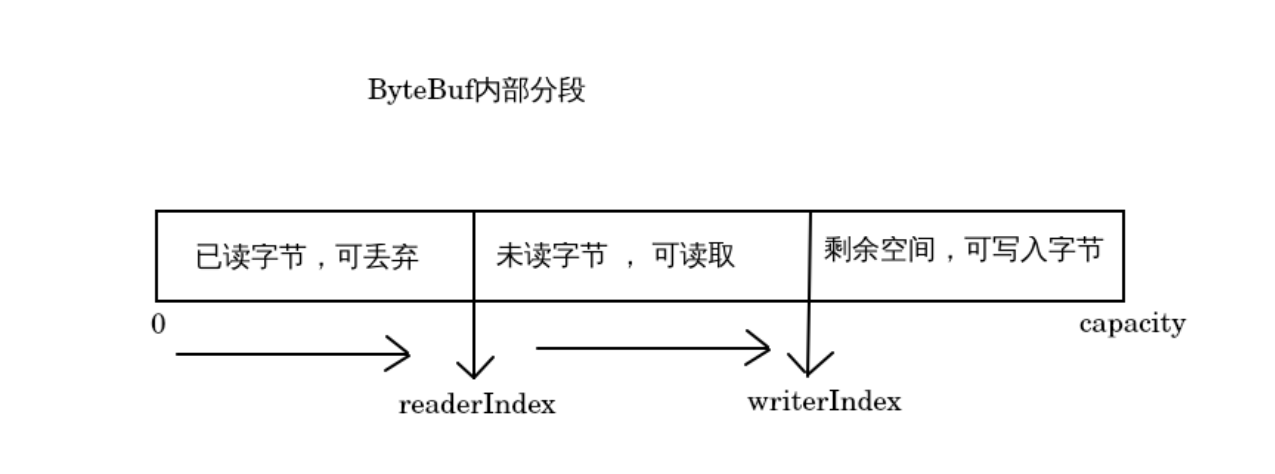
② ByteBuf 内部分段
上图介绍了在ByteBuf内部大致有3个分段,接下来我们就详细的介绍下这三个分段。
Ⅰ 可丢弃字节 Discardable Bytes
当readerIndex读取一部分字节后,之前读过的字节就属于已读字节,可以被丢弃了,通过调用 ByteBuf的discardReadBytes方法我们可以丢弃这个分段,丢弃这个分段实际上是删除这个分段的已读字节, 然后回收这部分空间加入可写入字节:
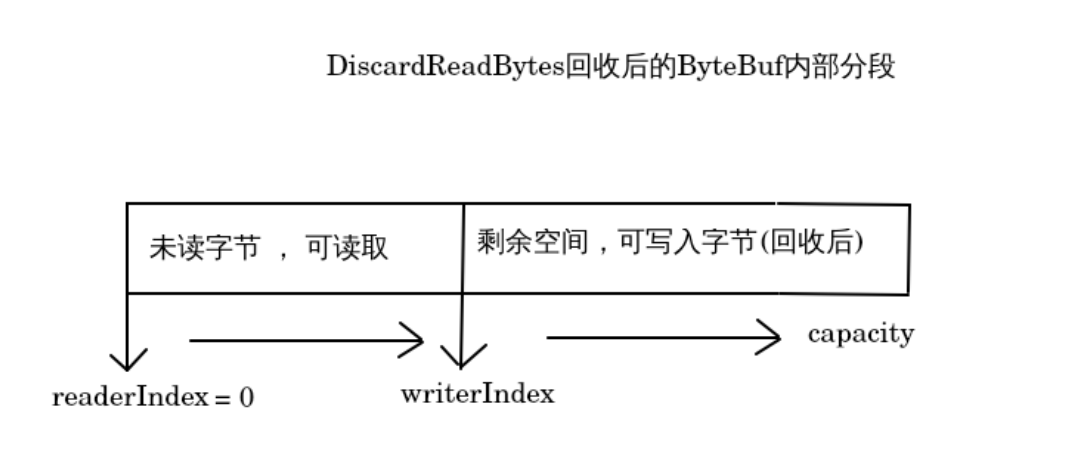
Ⅱ 可读取字节 Readable Bytes
ByteBuf的可读字节分段存储了尚未读取的字节,我们可以使用readBytes等方法来读取这部分数据,如果我们读取的范围超过了可读字节分段,那么ByteBuf会抛出IndexOutOfBoundsException异常,所以在读取数据之前,我们 需要使用isReadable方法判断是否仍然有可读字节分段。
Ⅲ 可写入字节 Writable Bytes
可写字节分段即没有被写入数据的区域,我们可以使用writeBytes等方法向可写字节分段写入数据,如果我们写入 的字节超过了ByteBuf的容量,那么ByteBuf也会抛出IndexOutOfBoundsException异常。
③ 索引管理
我们可以通过markReaderIndex,markWriterIndex方法来标记当前readerIndex和writerIndex的位置, 然后使用resetReaderIndex,resetWriterIndex方法来将readerIndex和writerIndex重置为之前标记过的 位置。
我们还可以使用clear方法来将readerIndex和writerIndex重置为0,但是clear方法并不会清空ByteBuf的内容,下面clear方法的实现:

其过程是这样的:
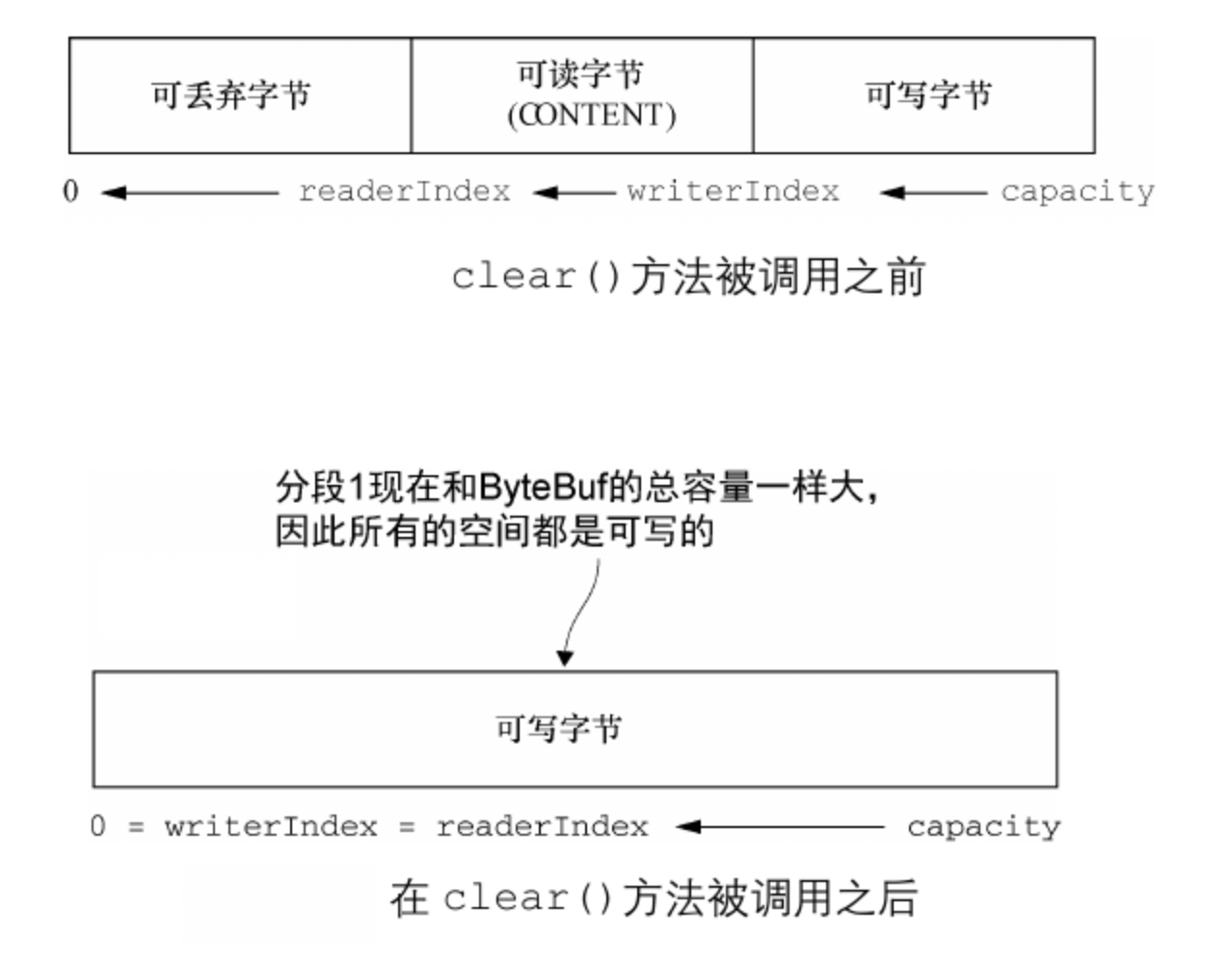
由于调用clear后,数据并没有被清空,但整个ByteBuf仍然是可写的,这比discardReadBytes轻量的多, DiscardReadBytes还要回收已读字节空间。
④ 查找操作
在ByteBuf中,有多种可以确定值的索引的方法,最简单的方法是使用ByteBuf的indexOf方法。
较为复杂的查找可以通过ByteBuf的forEachByte方法,forEachByte方法所需的参数是ByteProcessor, 但我们无需去实现ByteProcessor,因为ByteProcessor已经为我们定义好了两个易用的实现。
下面例子展示了寻找一个回车符,\ r的一个例子:
ByteBuf buffer = ...;
int index = buffer.forEachByte(ByteBufProcessor.FIND_CR);
⑤ 衍生缓冲区
衍生缓冲区是专门展示ByteBuf内部数据的视图,这种视图是由 duplicate(), slice(), slice(int, int),readOnly(), 和 order(ByteOrder) 方法创建的
🚨 这些方法都将以源ByteBuf创建一个新的ByteBuf视图,所以源ByteBuf内部的索引和数据都与视图一样, 但这也意味着修改了视图的内容,也会修改源ByteBuf的内容。即源 ByteBuf 和视图数据共享。举个例子,若需要操作某段数据,使用 slice(int, int):
Charset utf8 = Charset.forName("UTF-8");
// 创建一个 ByteBuf 保存特定字节串
ByteBuf buf = Unpooled.copiedBuffer("Netty in Action rocks!", utf8); //1
// 创建从索引 0 开始,并在 14 结束的新 ByteBuf 视图
ByteBuf sliced = buf.slice(0, 14);
System.out.println(sliced.toString(utf8));
// 更新源 Bytebuf 索引 0 的字节
buf.setByte(0, (byte) 'J');
// true:源 Bytebuf 更新,视图也会更新
assert buf.getByte(0) == sliced.getByte(0);
如果我们需要一个真实的ByteBuf的副本, 我们应该使用copy方法来创建,copy方法创建的副本拥有独立的内存,不会影响到源ByteBuf:
Charset utf8 = Charset.forName("UTF-8");
// 创建一个 ByteBuf 保存特定字节串
ByteBuf buf = Unpooled.copiedBuffer("Netty in Action rocks!", utf8); //1
// 创建从索引 0 开始,并在 14 结束的新 ByteBuf 拷贝
ByteBuf copy = buf.copy(0, 14);
System.out.println(copy.toString(utf8));
// 更新源 Bytebuf 索引 0 的字节
buf.setByte(0, (byte) 'J');
// false:源 Bytebuf 和拷贝副本互不影响
assert buf.getByte(0) != copy.getByte(0);
⑥ 读/写操作
读/写操作主要由2类:
get()/set()操作从给定的索引开始,保持不变read()/write()操作从给定的索引开始,与字节访问的数量来适用,递增当前的写索引或读索引
Ⅰ get/set
ByteBuf 的各种读写方法或其他一些检查方法可以看 ByteBuf 的 API,下面是常见的 get() 操作:
| 方法名称 | 描述 |
|---|---|
getBoolean(int) |
返回当前索引的 Boolean 值 |
getByte(int) , getUnsignedByte(int) |
返回当前索引的(无符号)字节 |
getMedium(int) , getUnsignedMedium(int) |
返回当前索引的 (无符号) 24-bit 中间值 |
getInt(int) , getUnsignedInt(int) |
返回当前索引的(无符号) 整型 |
getLong(int), getUnsignedLong(int) |
返回当前索引的 (无符号) Long 型 |
getShort(int) , getUnsignedShort(int) |
返回当前索引的 (无符号) Short 型 |
getBytes(int, ...) |
字节 |
常见 set() 操作如下:
| 方法名称 | 描述 |
|---|---|
setBoolean(int, boolean) |
在指定的索引位置设置 Boolean 值 |
setByte(int, int) |
在指定的索引位置设置 byte 值 |
setMedium(int, int) |
在指定的索引位置设置 24-bit 中间 值 |
setInt(int, int) |
在指定的索引位置设置 int 值 |
setLong(int, long) |
在指定的索引位置设置 long 值 |
setShort(int, int) |
在指定的索引位置设置 short 值 |
下面是用法:
Charset utf8 = Charset.forName("UTF-8");
// 创建一个新的 ByteBuf 给指定 String 保存字节
ByteBuf buf = Unpooled.copiedBuffer("Netty in Action rocks!", utf8);
// 打印的第一个字符,`N`
System.out.println((char)buf.getByte(0));
// 存储当前 readerIndex 和 writerIndex
int readerIndex = buf.readerIndex();
int writerIndex = buf.writerIndex();
// 更新索引 0 的字符 `B`
buf.setByte(0, (byte)'B');
// 打印出的第一个字符,现在是 `B`
System.out.println((char)buf.getByte(0));
// 断言成功,因为setByte 和 getByte 永远不会改变索引
assert readerIndex == buf.readerIndex();
assert writerIndex == buf.writerIndex();
Ⅱ read/write
现在,让我们来看看 read() 操作,对当前 readerIndex 或 writerIndex 进行操作。这些用于从 ByteBuf 读取就好像它是一个流。下面展示了常见的 read() 方法:
| 方法名称 | 描述 |
|---|---|
readBoolean() |
Reads the Boolean value at the current readerIndex and increases the readerIndex by 1. |
readByte() , readUnsignedByte() |
Reads the (unsigned) byte value at the current readerIndex and increases the readerIndex by 1. |
readMedium(), readUnsignedMedium() |
Reads the (unsigned) 24-bit medium value at the current readerIndex and increases the readerIndex by 3. |
readInt(), readUnsignedInt() |
Reads the (unsigned) int value at the current readerIndex and increases the readerIndex by 4. |
readLong(), readUnsignedLong() |
Reads the (unsigned) int value at the current readerIndex and increases the readerIndex by 8. |
readShort(), readUnsignedShort() |
Reads the (unsigned) int value at the current readerIndex and increases the readerIndex by 2. |
readBytes(int,int, ...) |
Reads the value on the current readerIndex for the given length into the given object. Also increases the readerIndex by the length. |
每个 read() 方法都对应一个write()。下面展示了常见的 write() 方法:
| 方法名称 | 描述 |
|---|---|
writeBoolean(boolean) |
Writes the Boolean value on the current writerIndex and increases the writerIndex by 1. |
writeByte(int) |
Writes the byte value on the current writerIndex and increases the writerIndex by 1. |
writeMedium(int) |
Writes the medium value on the current writerIndex and increases the writerIndex by 3. |
writeInt(int) |
Writes the int value on the current writerIndex and increases the writerIndex by 4. |
writeLong(long) |
Writes the long value on the current writerIndex and increases the writerIndex by 8. |
writeShort(int) |
Writes the short value on the current writerIndex and increases thewriterIndex by 2. |
writeBytes(int,...) |
Transfers the bytes on the current writerIndex from given resources. |
下面是用法:
Charset utf8 = Charset.forName("UTF-8");
// 创建一个新的 ByteBuf 保存给定 String 的字节。
ByteBuf buf = Unpooled.copiedBuffer("Netty in Action rocks!", utf8);
// 打印的第一个字符,`N`
System.out.println((char)buf.readByte());
// 存储当前的 readerIndex 和 writerIndex
int readerIndex = buf.readerIndex();
int writerIndex = buf.writerIndex();
// 更新索引 0 的字符 `B`
buf.writeByte((byte)'?');
// 断言成功,因为 writeByte() 移动了 writerIndex
assert readerIndex == buf.readerIndex();
assert writerIndex != buf.writerIndex();
4. ByteBufHolder
从表面理解起来,ByteBufHolder是ByteBuf的持有者,的确没有错。
ByteBuf几乎唯一的作用就是存储数据,但在实际的数据传输中,除了数据,我们可能还需要存储各种属性值,Http便是一个很好的例子。 除了Http Content,还包括状态码,cookie等等属性,总不能把这些属性与Content存储在一个ByteBuf中吧, 所以Netty提供了ByteBufHolder。ByteBufHolder为Netty提供了高级特性的支持,如缓冲区持化,使得可以从池中借用ByteBuf,并且在需要的时候自动释放。
以下是ByteBufHolder常见的方法:
content: 返回这个ByteBufHolder所持有的ByteBuf。copy: 返回ByteBufHolder的深拷贝,连它持有的ByteBuf也拷贝。
5. ByteBuf 分配
前面介绍了ByteBuf的一些基本操作和原理,但却并未说明如何分配一个ByteBuf,这里将讲解ByteBuf的分配方式。
① ByteBufAllocator
为了减少分配和释放内存的开销,Netty通过 ByteBufAllocator 实现了ByteBuf的池化。以下是ByteBufAllocator 的常见方法。
buffer: 返回一个基于堆或直接内存的ByteBuf,具体取决于实现。heapBuffer: 返回一个基于堆内存的ByteBuf。directBuffer: 返回一个基于直接内存的ByteBuf。compositeBuffer: 返回一个组合ByteBuf。ioBuffer: 返回一个用于套接字的ByteBuf。
我们可以通过Channel或ChannelHandlerContext的alloc方法获取到一个ByteBufAllocator

Netty提供了两种ByteBufAllocator的实现: PooledByteBufAllocator和UnpooledByteBufAllocator。 PooledByteBufAllocator池化了ByteBuf的实例以提高性能并最大限度的减少内存碎片,此实现的分配内存的方法 是使用 jemalloc,此种 方法分配内存的效率非常高,已被大量现代操作系统采用。 UnpooledByteBufAllocator则不会池化ByteBuf, Netty默认使用的是PooledByteBufALlocator。
② Unpooled 非池化
当Channel或ChannelHandlerContext未引用ByteBufAllocator时,就无法使用ByteBufAllocator来分配 ByteBUf,对于这种情况,Netty提供了Unpooled工具类,它提供了一系列的静态方法来分配未池化的ByteBuf。
③ ByteBufUtil
ByteBufUtil是ByteBuf的一个工具类,它提供大量操作ByteBuf的方法,,其中非常重要的一个方法就是 hexDump,这个方法会以16进制的形式来表示ByteBuf的内容。另一个很重要的方法是equals,它被用于判断 ByteBuf之间的相等性。
引用
《Netty 实战》
免责声明:本站所有文章内容,图片,视频等均是来源于用户投稿和互联网及文摘转载整编而成,不代表本站观点,不承担相关法律责任。其著作权各归其原作者或其出版社所有。如发现本站有涉嫌抄袭侵权/违法违规的内容,侵犯到您的权益,请在线联系站长,一经查实,本站将立刻删除。 本文来自网络,若有侵权,请联系删除,如若转载,请注明出处:https://yundeesoft.com/29919.html

